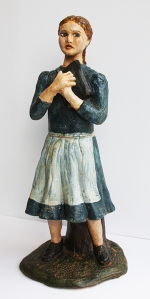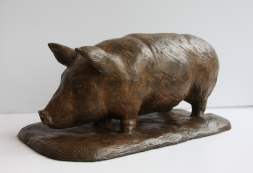Posted on May 27, 2015
A few months ago, a new business membership arrived for an art studio called Folkwerks, and as I do with any new member, I immediately jumped on their website to learn more about what they do. What I found was wonderful painting workshops offered by internationally known masters, sometimes spanning over many days so the student may truly gain knowledge from their instructor.
While exploring the website, I discovered that the face behind Folkwerks, Peg Isett McCormack, is also a skilled artist herself. Peg has much experience with watercolors, bronze casting, and a unique process called “chalkware,” which puzzled me because I had never before heard the term. I phoned Peg, eager to welcome her to the Arts Council, but to also learn more about this new medium.

Peg was happy to give me a quick history lesson, explaining how chalkware was first created during the Industrial Revolution as an inexpensive way to create plaster of paris gifts and decorations for the home. They were also popular during the first half of the 20th century as brightly colored carnival prizes, then later replaced by stuffed animals. Peg even mentioned that it was popular to use chocolate molds to cast the plaster animals and figures.
A true artist, Peg takes the process one step further and puts her real talent to work. First, she hand-sculpts her subjects out of clay, and then creates the mold from that sculpture. The mold is then cast with the plaster, and once it dries she will take the time to perfect the plaster by filing away imperfections. Once completed to her liking, Peg will take hours to hand-paint the piece with a water-based pigment. “I’m not aware of many other artists that do this entire process,” she remarked. “It’s very time-consuming, but I enjoy it.”

During the process of bringing her work to our space, we joked a little that the sculptures were “getting out on the town,” and they’d be “keeping us company,” as if they were very much alive and had personalities. However, once I viewed her work in person, I realized how her animals and figures really did take on a lifelike quality, each one with a unique personality.
Her work is certainly livening up the place, and I even catch myself giving her bronze pig, Homer, a little pat before I leave for the day!
In getting to know Peg a little more, we discussed some of her past experiences, inspirations, and artistic process:
In the past, you’ve had many exciting opportunities to travel abroad and study with renowned masters. What inspiration have you taken from these experiences?
Traveling abroad was like a fantasy. I was so inspired every place I looked! Sense of pride and the maintenance of old structures was amazing.
My first trip to France was the most exciting. Each day we would tour a museum or an old castle and I would think this will be the best day of my trip, and then the next day we toured the Opera House or did something just as exciting as the other days.
The pastel workshops I attended, two years in a row, were in Provence and Grenoble. For each workshop we roomed in beautiful old monasteries. The rooms were very basic with the country side so inspirational and exciting. We traveled to the Asylum where Van Gogh lived for several years. We actually painted plein air in the lavender gardens in the Court Yard. It was a wonderful experience. Experiencing the architecture, art work, museums, galleries, cafes, quaint little shops in very old buildings was very inspirational.
It seems animals are often the subject you paint and sculpt, especially farm livestock. Where does this interest come from?
My Mother grew up on a farm in Shoemakersville, PA. She was one of 12 children. When I was a child we would go to visit and then eventually to help to take care of my grandparents. When I was at a very young age my grandparents still had cows, chicken, ducks, pigs, and lots of cats. We loved playing in the barn – jumping from the hay bales and running down to the creek to fish and swim. These memories have inspired me to sculpt and paint animals. I love the bright colors of the rooster and the wooly soft texture of sheep. Pigs also have always fascinated me. The animals always give me a feeling of freedom and joy.
How did your interest in creating and casting molds begin? What do you find to be the most satisfying about the process?
At Parkland High School we had the opportunity to do sculpture. I sculpted a big rooster and a small rabbit. I loved sculpting, but did not know where to go to sculpt and I wanted to be able to reproduce the pieces. I had no idea how or where I would have the opportunity to do it.
In the 80s, I started taking sculpture classes at Baum Art School. Richard Lieberman, the instructor, never fired his clay pieces. Many of the other students didn’t either, and most of them would cast their piece with a waste mold or a rubber mold. One of the students was excellent at making rubber molds. The first piece I cast was a bust. I used a waste mold – only one casting. Soon I was sculpting roosters, chickens, sheep, etc. I wanted more than just one casting so I had Lou Stevenson make molds of my pieces. I learned how to cast, clean, file and paint my pieces. That was in 1988.
What artistic accomplishments are you most proud of?
Another student in my class suggested I send pictures of my pieces to a magazine for publication. She was a graphic artist and her work had been published. I felt I had nothing to lose, so I sent pictures and a letter to Country Home Magazine. I planned on sending them to several other magazines, but to my surprise Country Home wrote and told me they wanted to do a four-page feature on my work. That is when I started to refer to my work as chalkware. The pieces are chalkware because they are cast in hydrocal (a form of plaster, but stronger) and my pieces are primitive.
Thank you to Peg for allowing us to have her creations – it has been a pleasure! Come stop by the Arts Council office and view her wonderful sculptures and paintings, now through the end of June.

